Subscriber Benefit
As a subscriber you can listen to articles at work, in the car, or while you work out. Subscribe Now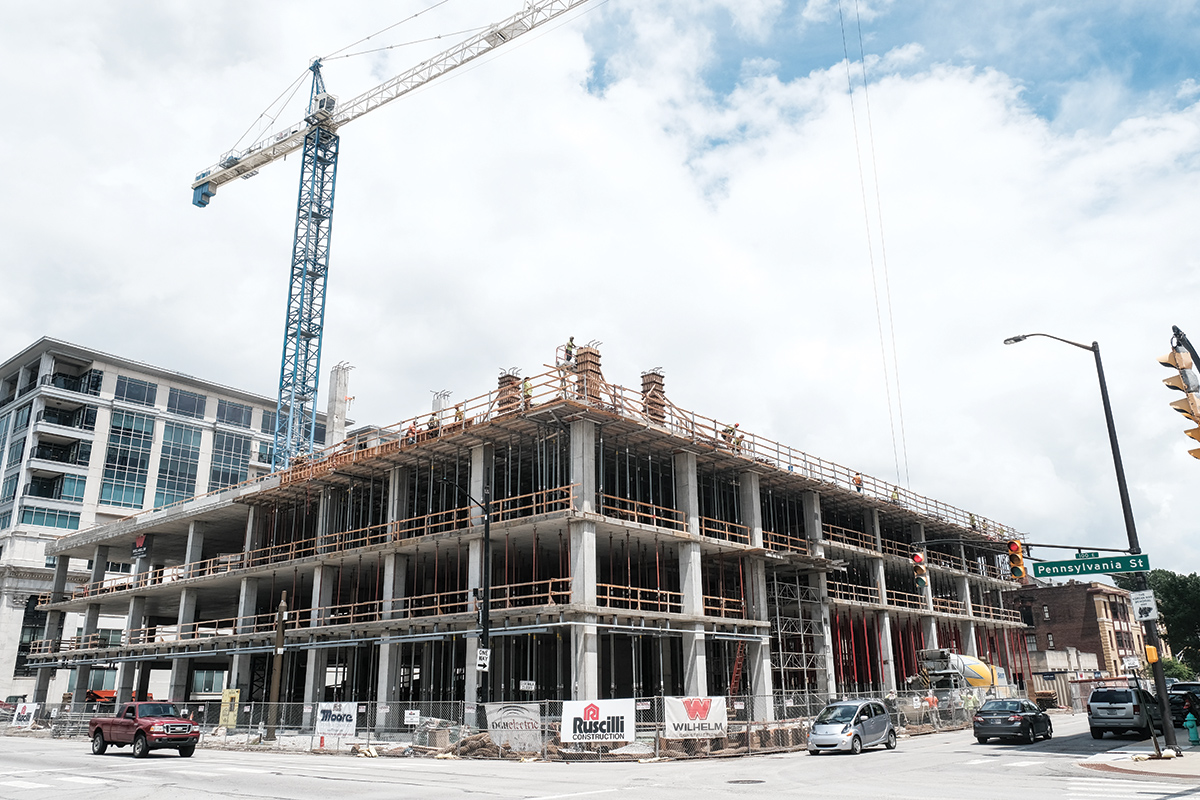
Mayor Joe Hogsett’s administration is again refining its expectations of developers who ask for city help in financing private projects, with the goal of increasing the amount of affordable housing and reducing the city’s long-term debt.
For the past five years, the city’s Department of Metropolitan Development has required developers seeking tax-increment-financing dollars—a key instrument in the city’s incentives toolbox—to include a public art component (usually around 1% of the development cost) in their projects, along with improvements to pedestrian-oriented infrastructure like sidewalks.
The agency has also required commitments from apartment builders to set aside 20% of newly developed units for people making 80% of the area’s median income of $81,600, based on data from the U.S. Department of Housing and Urban Development.
Now, the city is doubling down on its effort to increase affordability, with a new rule aimed at lower-income residents. It’s mandating that multifamily developers set aside either:
◗ 10% of units for those making 50% of the area median income, or
◗ 5% of units for those making 30% of the area median income.
The new rule will replace the 20/80 requirement.

“We are looking to, essentially, deepen affordability,” said Scarlett Martin, director of the Department of Metropolitan Development. In some parts of the city, she said, those making 80% of the area’s median income can afford housing at market rate, a term that refers to the price of an apartment that has no rent restrictions.
Martin said a consultant evaluating the city’s residential market recently advised the Hogsett administration that it should “seek more affordability, even if it meant [having] fewer units” below market rate.
According to RentData.org, the average market rate for a two-bedroom apartment in Marion County is about $1,250 per month.
While the city does not currently track the number of subsidized affordable apartments in Indianapolis, Marion County has at least 918 units at 30% of area median income (which can cost no more than $551 a month for a two-bedroom unit) as part of projects that have received state tax credits, according to the Indiana Housing and Community Development Authority. It has 2,724 units at 50% of the area median income; those can cost no more than $918 a month for a two-bedroom unit.
The city’s new rule has been taking shape behind the scenes for months, with city officials now in negotiations with multiple developers seeking incentives generated by tax-increment financing districts. Essentially, TIFs allow the city to siphon away some of the taxes paid in a specific area to subsidize projects within that area.
The first project to face the requirement was the Union East development along McCarty Street. Steve Alexander, an Old Southside architect and spokesman for the project’s ownership group, said the project will follow the 10/50 requirement, after “evolving negotiations” with the city that began last summer.
Indianapolis-based TWG Development, which has had several projects supported by TIF in recent years, is also expected to receive incentives through the new framework in the coming months.
The firm’s $58 million Rise on Meridian project on the near-south side is expected to receive $6.5 million in developer-backed TIF bonds, after it committed to the city’s 30% affordability threshold. The project is also receiving $2.5 million in tax credits from the Indiana Economic Development Corp.
Developer-backed bonds require the developer to pay off the debt if tax revenue falls short.

Tony Knoble, president of TWG, said even with the new affordable-housing requirements, TIF funding “is a good tool.” And he said the housing requirements “are still very feasible, financially, for developers.
Knoble acknowledged that the income levels in the prior program left out a large number of the city’s residents.
“Someone making 70% to 80% of those levels in Marion County can still afford a nice apartment. They may not be able to afford the nicest apartment, but it’s not that big of a detriment in terms of income,” he said.
A person making 80% AMI could afford rental rates around $1,000 per month.
Adding apartments at a project at the prior levels “is not really expanding your rental base that much,” Knoble said. “These new levels, that’s something where you’re going to really provide housing to a much more economically diverse group than you would at 80% to 100%” of the area median income.
Big moves
The shift in strategy follows a years-long effort by the Hogsett administration to reevaluate its downtown TIF commitments, after considerable spending by former Mayor Greg Ballard’s administration on dozens of new ventures using tax-increment financing. Those projects included CityWay at $97 million and several multifamily projects along Massachusetts Avenue.
The Ballard team spent $30 million to $40 million annually from the TIF on non-bonded projects after property tax caps and the Great Recession limited the cash it otherwise had available.
By 2018, the city had an unrestricted cash reserve in the downtown consolidated TIF of less than $1 million. But that situation has improved. At the end of 2021, the downtown TIF reserve is expected to be $18 million, with $54 million committed to outstanding debt.
Indy’s downtown consolidated TIF district is a patchwork of irregularly shaped boxes, designed to balance the tax revenue needed to finance new developments with the revenue the city needs for its operations. Most TIFs are dissolved after 25 years, but a state statute allows the downtown TIF, which has a tax base of nearly $300 million, to continue through 2051.
TIF districts are created in one of two ways: as larger redevelopment areas, meant to spur extensive growth in a particular area, or as single-site districts that rely only on new revenue produced by the target project. In both cases, funds made available for projects come only from taxes generated by projects that are completed after the district is created.
“Whether it’s TIF or any other form of economic development tool, it’s rare that the boundaries that you create actually capture all economic activity associated with it,” said Drew Klacik, a policy analyst with the Indiana University Public Policy Institute. “And with TIF, it’s even quirkier, because you’re not just trying to fairly sync the economic benefits of the district, but you’re also trying to capture the spinoff growth—oftentimes not just the project itself.”
Developers typically prefer single-site TIFs, because they offer a more straightforward calculation for their project budgets and have greater favor with financial institutions, Knoble said.
But if a TIF district already exists, the city will often expand the boundaries to include the new development or look for ways to incorporate more prime parcels into a redevelopment area.
For example, the city is considering incorporating the former Angie’s List campus on the near-east side—an area now known as Elevator Hill—into the downtown TIF to support an anticipated $250 million in investment on the property. It did the same with the former GM stamping plant site—soon to be home of Elanco Animal Health’s new headquarters—several years ago, as part of a previous effort to redevelop the massive property.
Martin said the primary goal of adding Elevator Hill to the downtown TIF is “to look at what infrastructure activity is needed to support that development.”
She said determining whether a project that receives financial support goes into its own district or into an existing TIF is a “mechanics” question, determined by how well a development would mesh with other users in a particular area.
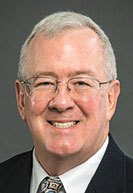
Michael Hicks, an economics professor at Ball State University, said local governments that regularly use TIFs must do so with an emphasis on precision.
“If you draw too big a circle … you essentially cut off all new revenue growth for anything but TIF for 25 years,” which reduces the revenue available to cities, schools, libraries and other taxing units, he said.
Developer backing
Dan Jacobs, president of Chase Development, recently received TIF dollars for two projects.
The first is a $40 million downtown development known as Block 20, which includes two sites near the Athenaeum. That property was drawn into its own TIF district in 2019.
The second is a new $24 million office headquarters for the Eight Eleven Group in Broad Ripple, which was placed in the Midtown TIF in 2020.
In addition to the city’s efforts to revamp its project requirements, the Hogsett administration is leaning more on developers to support their own projects through the use of developer-backed bonds, Jacobs said. The method, which calls for a firm to fill the gap if tax revenue comes up short, protects the city and its taxpayers from some of the financial risk of new projects.
“They’re kind of switching their role and sitting on the same side of the negotiating table with us—as more of a partner,” Jacobs said. Also, he said, there’s generally a formula for determining incentives used across the board, based on the revenue generated by the project, rather than determining incentives based on negotiation skill.
“By doing that, the developer has to be more responsible,” he said. “The city’s tax math works better, and essentially it becomes a true public-private partnership.”
That also means Indianapolis can spend money in the downtown TIF more broadly because the method saves the city money it would otherwise put toward projects, allowing it to get a boost in credit ratings, Martin said.
Hicks said while it’s not common for cities to put the onus on developers for incentives, the approach does put the city on better financial footing.
“It’s exactly what you should be doing in a city where there’s actual demand for new development,” Hicks said. “The worst position a city could be in is not to ask anything of new businesses.”
He added: “Indy is a hot enough, fast-growing enough city that it has every reason to start asking more of businesses.”
Positive outlook
The change in strategy for how developments receive incentives has gone a long way in helping the city shore up its financial footing, particularly in the downtown TIF district, officials said.

“You can see the health of the TIF itself, and over the last few years, the result of our approach, I think, tells the tale,” City Controller Ken Clark said.
In addition to building a surplus for the district, efforts to moderate TIF awards in recent years have allowed the city to invest dollars in other projects, including infrastructure and workforce development.
Within the district, more than two dozen projects have received TIF funding since 2018. All projects, Clark said, undergo a “but for” test—an evaluation of the benefit of a development as it compares to the incentives being sought and whether the project would advance without incentives—before they are taken to the city’s Metropolitan Development Commission.
In 2021 alone, downtown TIF dollars will be used for a litany of projects. About $25 million will go toward a plaza at Bankers Life Fieldhouse and $4.4 million to a parking garage at 16 Tech.
About $4.5 million is earmarked for improvements to West Market Street, while another $3.7 million is intended to help the Department of Public Works turn College Avenue downtown back into a two-way street.
And it’s expected that Elanco will receive $134.5 million in TIF for infrastructure and other improvements to the former GM stamping plant site later this year, as part of a three-party deal with the city and the IEDC. That deal would be the largest involving a private company to come through the city during the Hogsett administration, including in the downtown TIF district.
The Infosys campus at the former airport terminal received $45 million in TIF dollars.
In 2020, $4.5 million in downtown TIF was spent to expand the Indianapolis Cultural Trail, along with $3 million for the city’s mortgage assistance program during the pandemic.

Katie Culp is president and CEO of Indianapolis-based KSM Location Advisors, a firm that specializes in real estate economic incentives and works closely with the city of Indianapolis and other municipalities. She said the city’s TIF situation looks “very healthy.”
“Different administrations have different philosophies about how TIF should be used, and I think the Hogsett administration’s approach has been very consistent,” she said. “There are always going to be times, especially in this economy, where unexpected things will happen, so I think they’re trying to be conservative about it. And they’re doing that well.”
The Ballard administration spent $160 million on various downtown projects during the Republican’s eight years in office. The Hogsett camp has so far spent $66 million on single-time expenses, with another $54 million earmarked for 2021 that would bring the total to $120 million, with two years remaining in the mayor’s second term.
“They’ve made improvements that will make lives better for Indianapolis residents,” Hicks said, though he added that improvements like Georgia Street upgrades could have been paid for out of the city’s coffers instead.
Those improvements—from administrations past and current—have collectively racked up debt for the downtown TIF. While some debt has fallen off the city’s rolls in recent years, the city still owes hundreds of millions of dollars on outstanding bond issuances tied to the downtown TIF district.
In fact, nearly one-half—$649.8 million, as of Jan. 1—of the city’s overall outstanding debt of $1.3 billion is tied to downtown TIF bonds. Some of those bonds are expected to be paid off yet this year. But some of the largest—like those for CityWay ($73 million), 16 Tech ($34.6 million) and the JW Marriott project ($50.3 million)—won’t be paid off until 2036, 2040 and 2038, respectively. The last maturity date for current debt is slated for 2042.
The downtown TIF surplus is expected to grow over the next few years, with projections of $30.6 million for 2022, and upwards of $82.6 million by 2024.
Policy experts and developers said they are generally confident the city has the financial stamina to support continued TIF expenditures, too—particularly if they continue with the strategy that prioritizes affordability.
“I think they’re being good shepherds of their money, because they’re picking [firms] that they know will deliver when they’re given developer-backed bonds,” said TWG’s Knoble.
As part of its efforts to maintain strong financial footing, the city plans to continue having 150% cover for all future TIF bond payments. That means, if the city owes $50 million in debt service payments in a year, it must bring in at least $75 million in taxes through the district.
The city anticipates a cover of about 170% for 2020, bringing in $85.9 million in tax collections with debt payments totaling $50.3 million. State law limits cover to no more than 200%.
Clark, the controller, said he’s confident the city can continue to cover its debts in perpetuity. “I believe that we’re on a positive trajectory,” he said.
To stay clear of deficits, “we have backup on backup on backup to make sure that we don’t get in that situation,” Clark said. “And we’ve done that on purpose.”•
Editor’s note: This story has been updated to remove a reference to the Community Justice Campus, which is being paid for through city-backed bonds, not TIF dollars.
Please enable JavaScript to view this content.

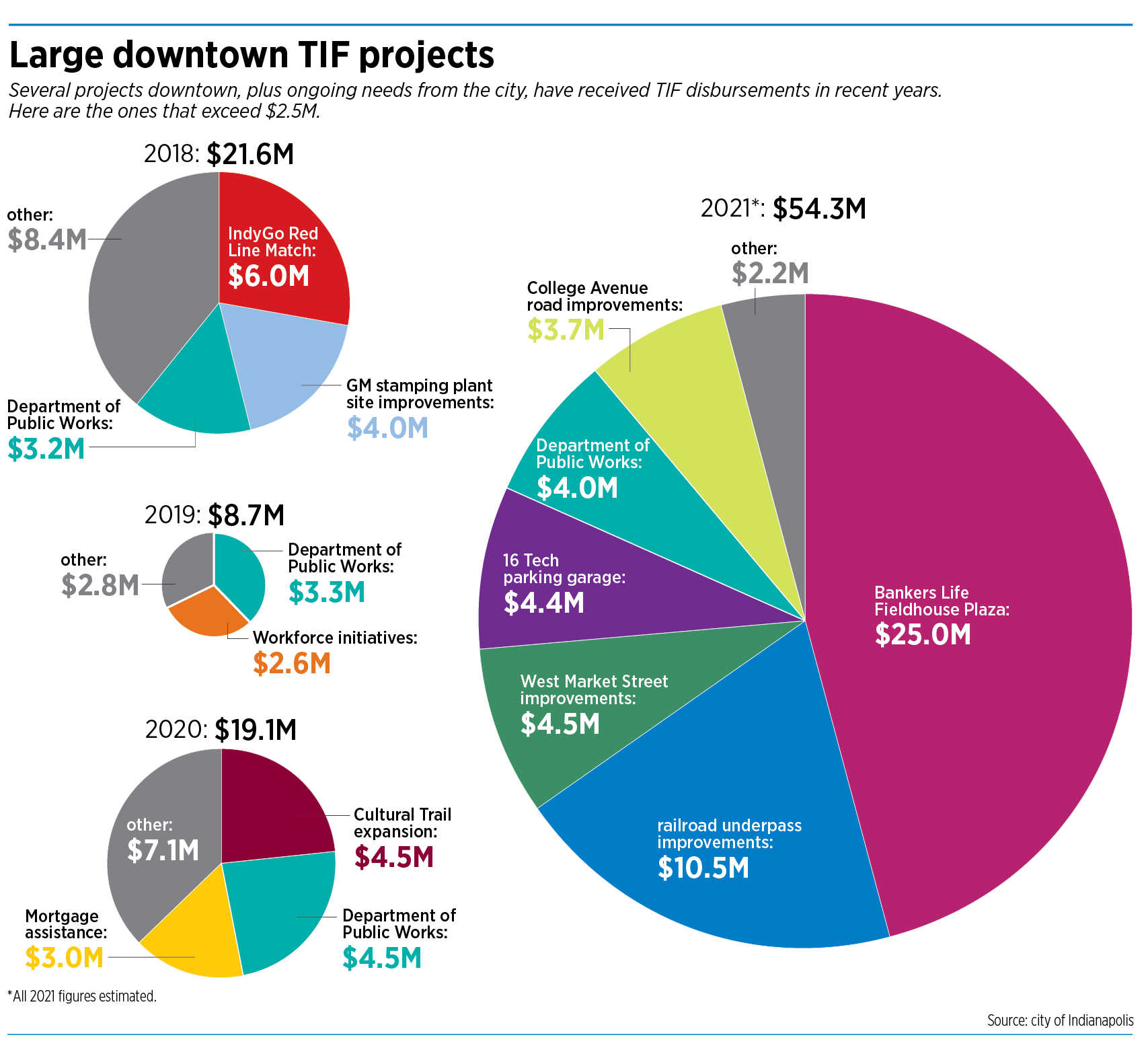
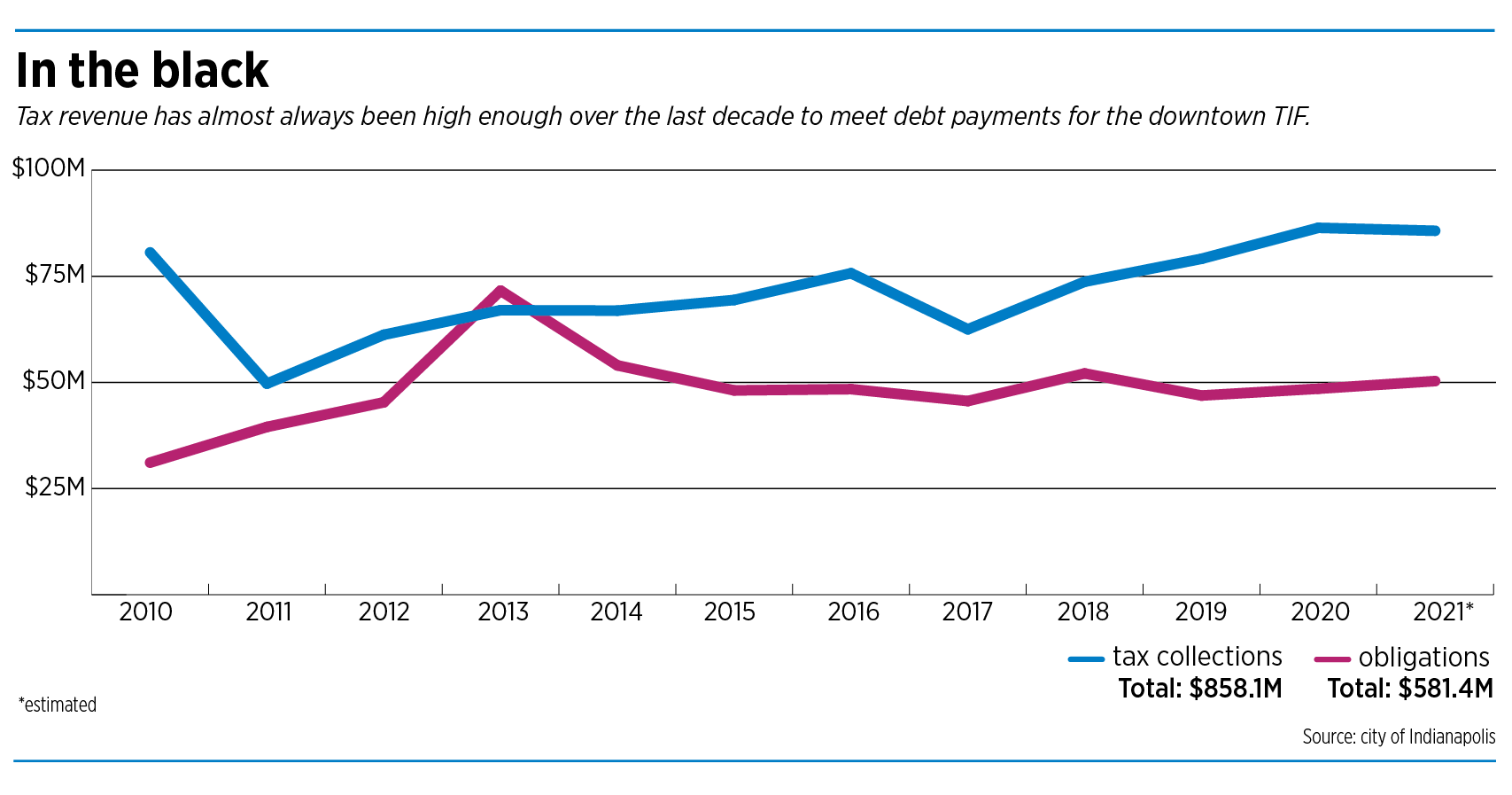
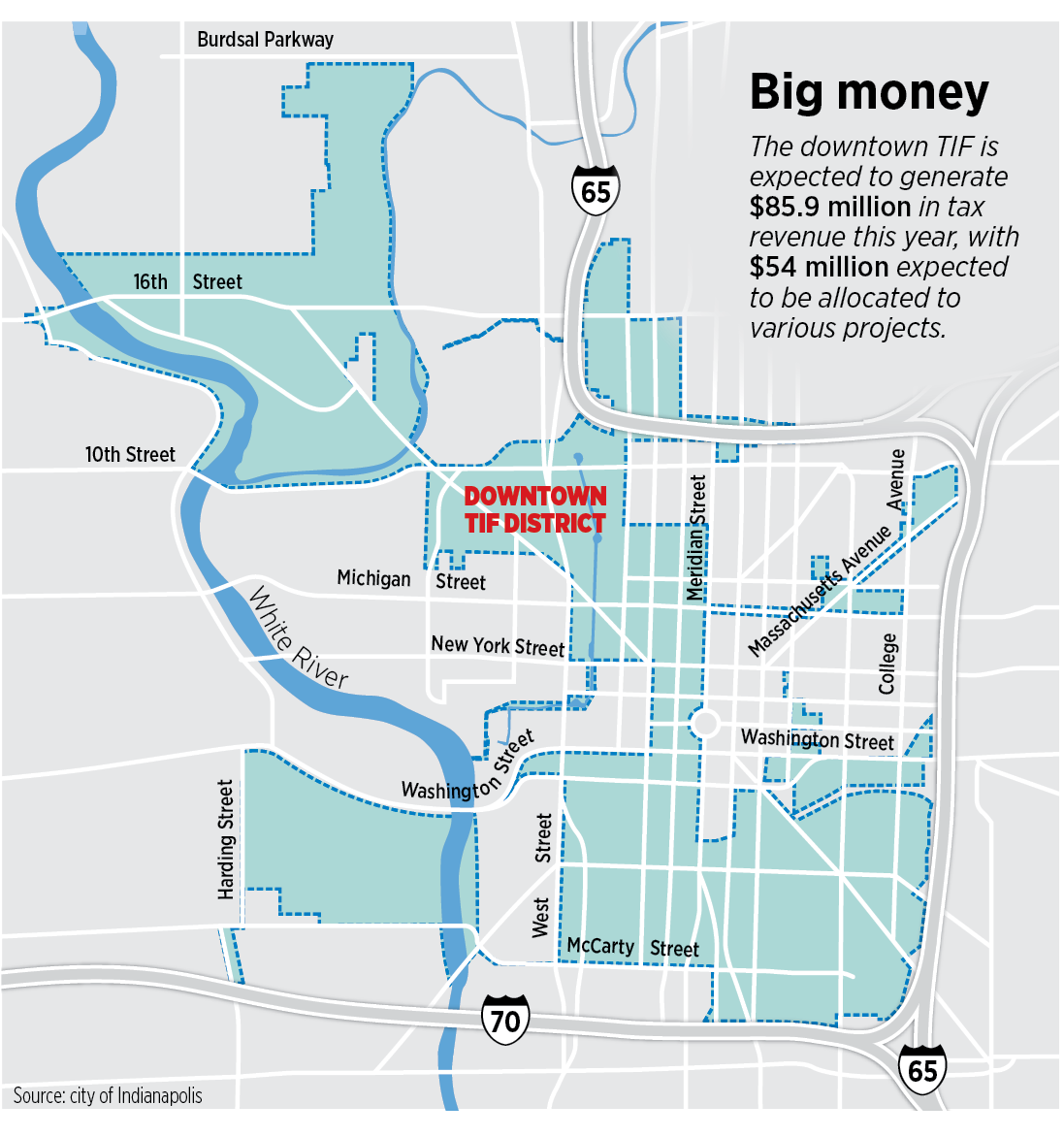
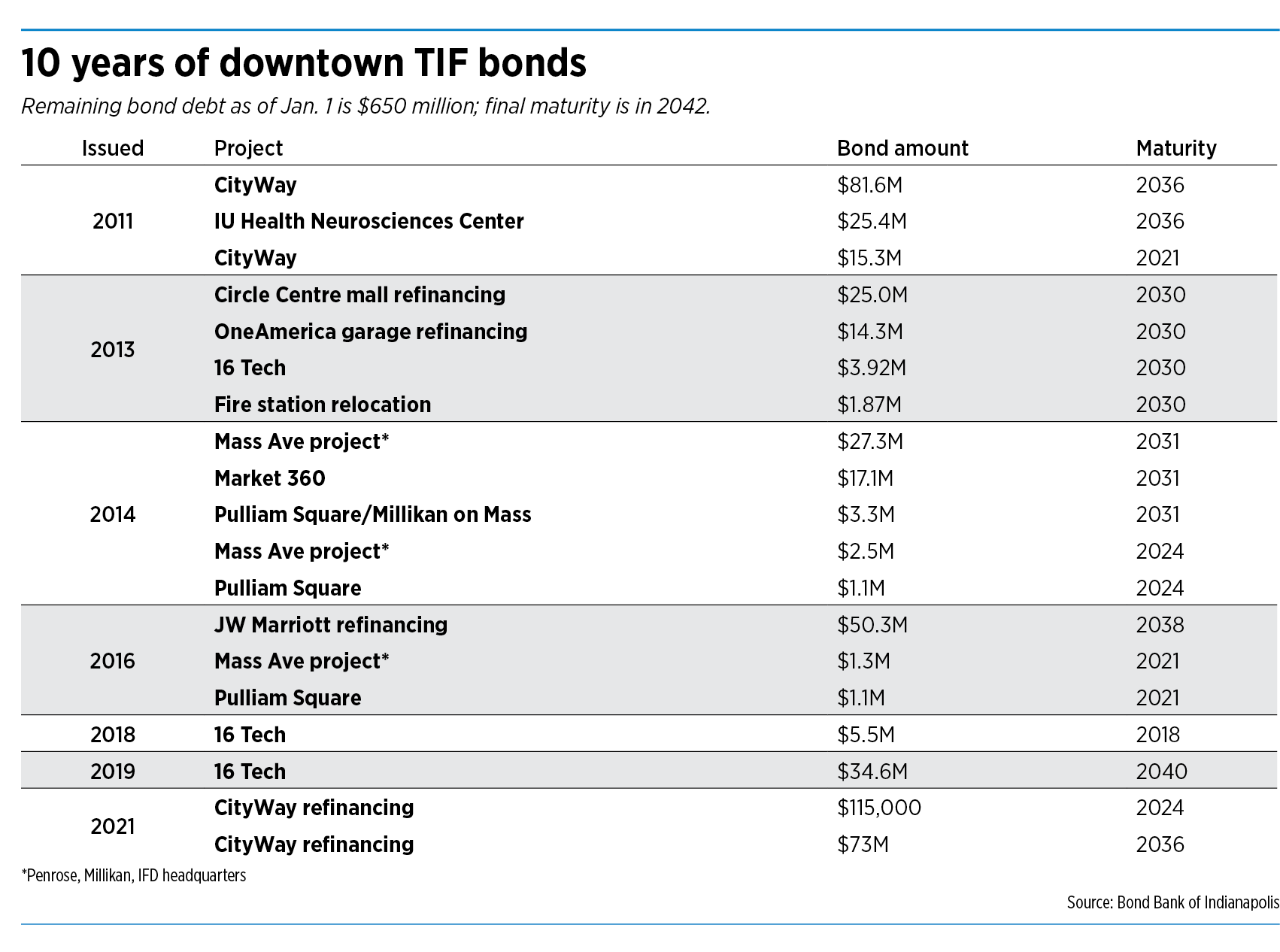
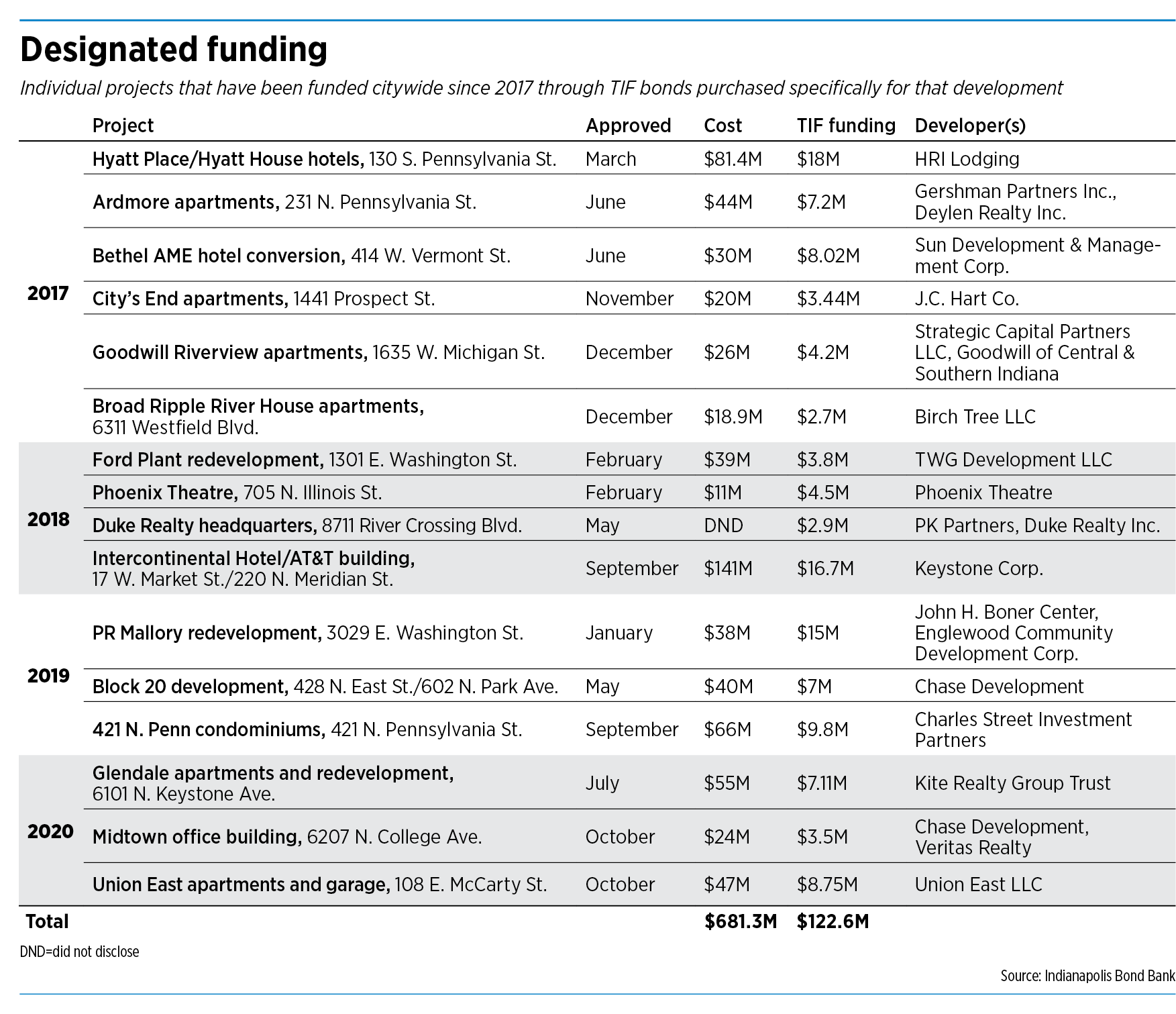
City mortgages more of future for the benefit of politically connected developers.
You apparently don’t remember downtown before stadiums, convention center, hotels, restaurants, mall, and apartments. More like “leveraging the future”.
I remember. I’m also familiar with what the overindulgence of TIFs and abatements does to a city, especially one with a low density such as Indianapolis. I’m also aware that Indianapolis is much larger than it’s downtown area and a significant chunk of that area is seeing continued degradation – one could easily say is enhanced by the downtown TIF alone.